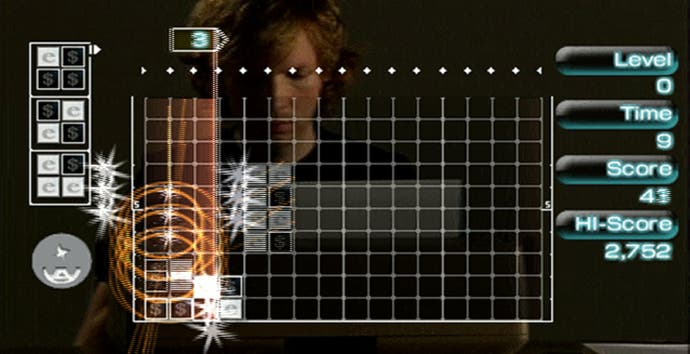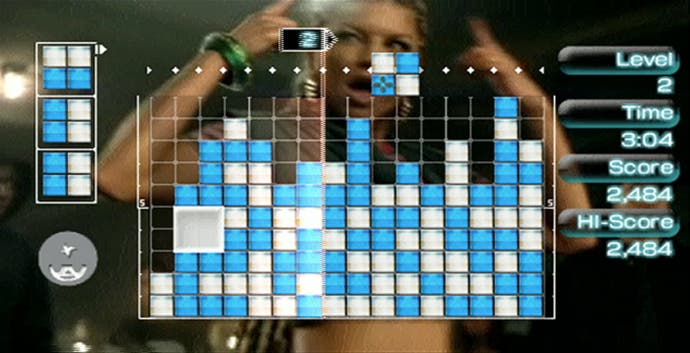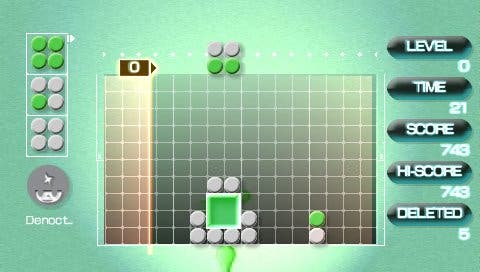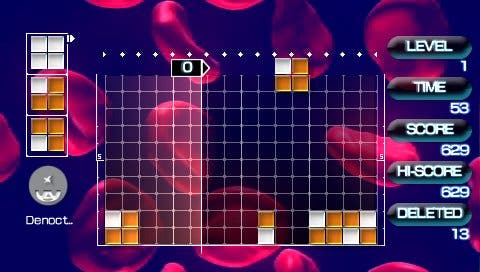Lumines II
Block-rocking beats?
As much as I love trains and aeroplanes, which is not at all, there is something to be said for allowing them, for they are the places where I can slide most completely under the blanketing layers of a complicated puzzle game, and find comfort and peace. In fact, the history of my affection for the genre is best plotted against advances in conveyance. Tetris was the rickety old National Express that took my Year 7 class to the Isle of Wight; Meteos was the Eurostar from Waterloo; and Lumines was the First Great Western to Bath Spa. Historic Bath, whose skyline is that manner of picturesque that calls for no other word, or at least so I'm told - I was close to 400,000 at that stage so I wasn't about to look up.
And so the arrival of Lumines II on my doorstep last Saturday morning left me in a muddle, because I had nowhere to go. I couldn't rely on the 78 minutes of Silverlink necessary to play golf with my Dad because he was looking after my sister (and because, you know, it's October). I couldn't call upon Central Trains' or One Railway's 84 minutes to Cambridge, because my friends there have gone back to university. And I couldn't just do laps of the Circle Line, because the bastard engineers had ripped holes in it. So in the end I did what any sensible critic would have done under the circumstances: I put C'était un rendez-vous on loop, turned up the volume and sat 12 inches from the screen playing the game with my headphones on.
Anyway, Lumines II.

The fundamentals that helped the first game to sell over 700,000 copies remain more or less completely the same: you control squares made of four smaller block pieces that are descending into a play area that is wider than it is tall; the idea being to create arrangements of smaller blocks that comprise only one of the two available colours. Once your arrangements are two or more blocks in diameter, a vertical "timeline" that sweeps the screen from left to right will remove them. All the while this is going on, music plays over the top, and your actions - moving blocks left or right, slamming them down with the d-pad down button to add depth to an arrangement before the timeline hits, or just sweeping them away - create smaller musical ticks that infuse the composition with a layer of individuality. The only other modifying element is the occasional jewel-block, which, when forming part of a deletable assembly, will also take with it in any blocks of the same colour connected by touch.
New gameplay elements are conspicuously absent. The mobile phone version of Lumines introduced Tetris-style shapes, additional power-up blocks and other variations that, while perhaps muddling the original game's simplicity, certainly spoke of a desire to demand new skills of the player. But I've not encountered anything like that in the first six hours or so of investigating each of the game's modes. The scoring system, with its 1000-point bonuses for deleting all the blocks of one colour, and 10,000-point bonuses for complete deletion, as well as multipliers for mass-deletions, appears the same, and none of the shape-shifting of the mobile version is immediately apparent. Indeed, it's all a bit Lost World: same dinosaur, different meal.

The protein here largely comes from an array of new skins. Skins of course are Lumines' "levels"; each changes the colours or design of the blocks, and alters the movement characteristics of both the blocks and timeline (although, in line with the above, the timeline doesn't do anything massively unexpected like sweeping back and forward, or up and down). Lumines II's skins number more than 60, and include some of the Japanese artists (and indeed the same songs) that filled out the original, including new material from the excellent Mondo Grosso (joined here by countrymen Genki Rockets and Techriders), but the spotlight is more likely to fall upon the real newcomers: the Westerners. Represented by the likes of Fatboy Slim, Black Eyed Peas, Gwen Stefani and (perhaps more creditably) The Go! Team and New Order, the Western cast are accompanied by their MTV output, so as you dance blocks across the aural horrorscape of "Hollaback Girl", you can also watch blonde Caucasian women bopping along in the background (surely a good enough excuse to accidentally let the screen fill up a bit).
Whether or not my existing knowledge of some of these songs (intimate knowledge, in some boozy-gig-recollection cases) makes it easier or harder to accept and appreciate the musical elements of the gameplay is something I haven't made my mind up about yet, and is probably a question better answered by the long-play approach of November's review, but, if it's any indication, I have found myself comfortably queuing up the likes of "Bottle Rocket" next to the more obscure Japanese output without feeling as though the quality dips and soars especially from one to the other. In other words, I generally like what they've done, and some of the musical elements used to accentuate the player's actions are imaginative and interesting - Beck's Black Tambourine level, played at a decent tempo, sounds a bit like dancing with a rattlesnake, and New Order's Regret level is perfectly judged.

A better target for the preview is the new things you can do, of which the abovementioned customised playlists are one. Skin Edit mode, seen also in last week's Lumines Live Xbox 360 release, allows you to create arrangements of skins that you've already unlocked and play through them once or on endless repeat (until the screen fills up and it's game-over, anyway). Another interesting area of customisation not seen last week is the Sequencer, which allows you to edit a handful of songs (though not, it would appear, any of the big-name ones). Here you can rename tunes, alter the tempo and even fiddle with them using a MIDI sequencer, before saving them off and calling them into your Skin Edit compilations. The Data Exchange menu option - though not something with which I could experiment due to having only one copy of the game - presumably allows you to share your adaptations and playlists.
Otherwise the modes line-up is quite familiar, but with tweaks in places. Challenge mode now features three difficulty classes, although I had trouble in my first handful of hours discerning how they differed - mainly because I was busy being hypnotised by all the new skins I was playing through, which vary from class to class. Vs. CPU mode still features a range of AI opponents to face off against in the multiplayer Duels, where you both occupy the same play are and fall under the control of the same timeline, with the goal being to push a dividing line toward the other player through deletions, until they're choked into filling up their remaining space and losing. Time Attack offers 60, 180, 300 and 600 seconds' worth of deleting as many blocks as possible. Puzzle continues to have you create specific shapes in the stacks of blocks, although now there are around 100 arrangements, and the latter ones are extraordinarily challenging. Finally Mission mode, then, which is also introduced on Xbox 360, and most of the time involves clearing a certain number of lines within a certain number of passes. There are Easy, Hard and Super Hard sections to Mission mode, and also variations, like having to carve a gap to the bottom of a stack of disorganised blocks five rows tall.

On top of that, the game also offers better tracking of individual statistics for modes (cumulative play-time, challenge scores and high-score tables, and stats like the average time taken to dispense with Puzzle levels), networked ad hoc multiplayer Duels, as before, the option to share a trial version with another PSP owner (multiplay requires two UMDs, mind), and the chance to play a demo of Q Entertainment's other forthcoming PSP title, Every Extend Extra.
All of which is wrapped up in the same slick presentation that you may already have witnessed on Xbox 360; tiered menus with spoken titles, and a trance-like menu theme that's managed to play interminably behind this word-processor without winding me up to the point of violence. Which is more than can be said for Rendez-vous, which started to annoy me within about half an hour.
Anyway, look out for a full review early next month, ahead of the game's 17th November release, when we'll more thoroughly examine whether these new elements are merely superficial improvements to what was already a phenomenally absorbing puzzle game or something grander, and what else the game has to offer experienced players as they delve further under the blanket. I'm not sure whether I'll be your compère for that particular event, but I'll be planning a weekend of remote activities fit for a few long-distance Challenge sessions just in case.
Lumines II is due out exclusively on PSP on 17th November.






.png?width=291&height=164&fit=crop&quality=80&format=jpg&auto=webp)



